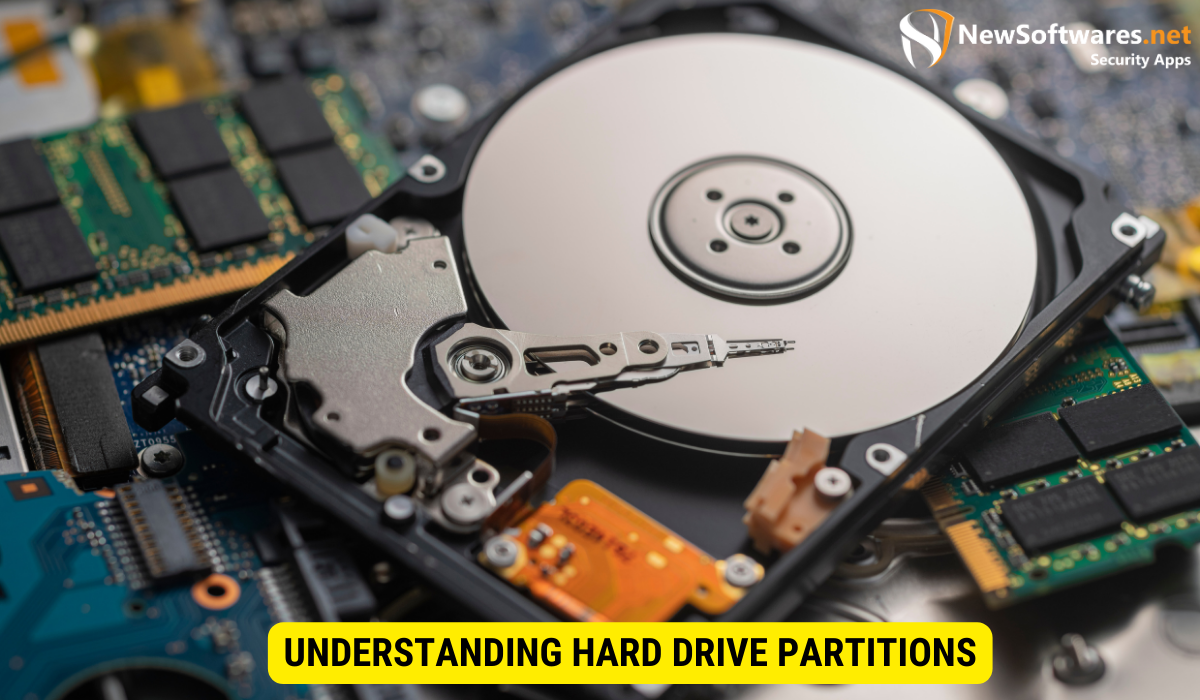Data recovery from a hard drive with a missing partition and encryption is possible but challenging, as encrypted data requires the decryption key for access.
Data loss can occur to anyone, and it can be a real nightmare if you have an encrypted hard drive with a missing partition. This article will explore whether data can be recovered from such a scenario. Together, We will delve into the intricacies of hard drive partitions and their role in data storage. We will also discuss the impact of encryption on data recovery and take a glimpse into the data recovery process itself. Together, we will go through the challenges of recovering encrypted data from a missing partition and explore preventive measures and best practices to stay away from such a situation.
Understanding Hard Drive Partitions

Before diving into data recovery, let’s first understand what hard drive partitions are and how they function.
Hard drive partitions are essentially logical divisions of a physical hard drive. They serve multiple purposes, including organizing data, improving performance, and facilitating different operating systems on the same drive. Each partition has its own file system and directory structure, creating the illusion of multiple independent drives.
When you partition a hard drive, you allocate specific portions of the drive’s storage space to each partition. This allows you to separate different data types into distinct partitions, such as the operating system files, program files, and personal files. By doing so, you can easily manage and access your data without the risk of accidentally modifying or deleting critical system files.
Furthermore, hard drive partitions can also enhance the performance of your computer. By separating the operating system and program files from personal data, the read and write operations can be more efficiently distributed across different partitions. This can result in faster access times and improved overall system performance.
The Role of Partitions in Data Storage
Hard drive partitions play a crucial role in data storage. They not only provide a structured way to organize your files but also help in protecting your data. By separating your files from the operating system files, you can decrease the risk of data loss due to software issues or system crashes.
Moreover, partitions enable multiple operating systems on the same physical hard drive. This is particularly useful for users who need to run different operating systems on their computers, such as Windows and Linux. Each operating system can be installed on a separate partition, allowing you to switch between them without conflicts.
Additionally, partitions can be used to create a backup strategy. Dedicating a partition solely for backups allows you to easily store and retrieve your important files. This ensures that even if one partition becomes inaccessible or corrupted, your backup partition remains unaffected, safeguarding your critical data.
What Happens When a Partition Goes Missing?
If a partition goes missing, the system can no longer locate or access the data stored on that particular partition. This can occur for various reasons, including accidental deletion, hardware failure, or software corruption.
When a partition is missing, the operating system may fail to recognize it, resulting in data loss and potential difficulties in data recovery. In such cases, specialized data recovery tools and techniques are often required to retrieve the lost data from the missing partition.
It is important to note that attempting to recover data from a missing partition should be done cautiously. Any improper actions or attempts to recover data without proper knowledge and tools can further injure the partition and make data recovery more challenging.
Therefore, it is suitable to seek professional assistance from data recovery experts with the expertise and experience to safely recover data from missing partitions. They can employ advanced techniques and specialized software to retrieve your valuable data while minimizing the risk of further data loss.
The Impact of Encryption on Data Recovery
When it comes to data recovery, encryption adds an second layer of difficulty to the process. Let’s explore the basics of data encryption and how it affects data accessibility.
The Basics of Data Encryption
Data encryption involves using algorithms to convert data into an illegible format, which can only be deciphered with the appropriate decryption key. This provides an extra level of security, ensuring that even if unauthorized persons gain access to the encrypted data, they won’t make sense of it without the decryption key.
Encryption algorithms use composite mathematical formulas to scramble the data, making it virtually impossible to understand or extract meaningful information without the decryption key. This process involves converting the original data into a series of random characters, making it appear as gibberish to anyone who doesn’t possess the decryption password.
There are different types of encryption algorithms, counting symmetric and asymmetric encryption. Symmetric encryption uses the same pass key for encryption and decryption, while asymmetric encryption uses a couple of keys – a public key for encryption and a private key for decryption.
When data is encrypted, keeping the decryption key secure is crucial. Without the key, it becomes extremely difficult, if not impossible, to recover the original data. This is where the impact of encryption on data recovery becomes evident.
How Encryption Affects Data Accessibility
While encryption enhances data security, it can pose challenges during data recovery. The encrypted data on the missing partition can remain inaccessible without the decryption key. This means that even if the missing partition is found and recovered, its encrypted data may still be unreadable and unusable.
When attempting to recover encrypted data, data recovery specialists face the challenge of obtaining the decryption key. Without the key, the recovered data may remain locked and useless. Sometimes, the decryption key may have been lost, forgotten, or destroyed, further complicating the data recovery process.
Moreover, the strength of the encryption algorithm used can significantly impact the chances of successful data recovery. Strong encryption algorithms make it extremely difficult to crack the encryption without the decryption key, even for experienced data recovery professionals. The data recovery process may require extensive time, resources, and specialized knowledge.
On the other hand, weak encryption algorithms may be susceptible to brute-force attacks, where an attacker systematically tries all possible combinations until the right decryption key is found. However, the time and computational power required for such attacks can be significant, even with weak encryption.
It is important to note that encryption is not the only factor that affects data recovery. Other factors, such as physical damage to the storage device or accidental deletion, can also hinder recovery. However, encryption adds a layer of complexity, making it crucial to have the decryption key for successful data recovery.
In conclusion, while encryption provides enhanced data security, it also introduces challenges during data recovery. The need for the decryption key and the strength of the encryption algorithm used can significantly impact the accessibility and recoverability of encrypted data. Data recovery specialists must carefully consider these factors and employ specialized techniques to overcome the hurdles of encryption.
The Process of Data Recovery
Now that we better understand hard drive partitions and encryption let’s explore the data recovery process and what it entails.
Initial Assessment and Diagnosis
The first step in data recovery is to assess the extent of the problem and diagnose the cause of the missing partition. This typically involves examining the physical condition of the hard drive, analyzing any error messages or symptoms, and determining the potential causes for the missing partition.
Tools and Techniques for Data Recovery
Once the initial assessment is complete, data recovery professionals employ various tools and techniques to recover the missing partition and retrieve the data. These methods can include specialized software, hardware repairs, or even cleanroom procedures for more severe cases.
Challenges in Recovering Encrypted Data from a Missing Partition

Recovering encrypted data from a missing partition presents its own set of challenges. Let’s examine some technical hurdles data recovery experts may encounter in such scenarios and the importance of seeking professional assistance.
Technical Hurdles in the Recovery Process
Decrypting data without the appropriate decryption key is an incredibly difficult task. Even with advanced techniques, it can take significant time and resources to recover encrypted data from a missing partition. Professional assistance is crucial, as data recovery experts have the necessary expertise and tools to tackle such complex cases.
The Importance of Professional Assistance
Attempting to recover encrypted data from a missing partition without professional help can lead to further complications and potentially permanent data loss. Data recovery experts have the experience and knowledge to navigate the intricacies of data encryption and recovery, maximizing the chances of successfully retrieving your valuable data.
Preventive Measures and Best Practices
While data recovery is crucial in case of a missing partition with encrypted data, it is always better to stop such situations from occurring in the first place. Here are some preventive measures and best practices to keep your data safe:
Regular Backups and Data Protection
Regularly backing up your data is essential to ensure that you have a recent copy of your files, even if you encounter data loss. Backup solutions, for instance cloud storage or external hard drives can provide additional protection for your data, reducing the impact of a missing partition.
Safe Handling of Hard Drives
Handling hard drives is crucial to avoid physical damage and potential data loss. Avoid exposing hard drives to extreme temperatures, shocks, or magnetic fields. When transporting or storing hard drives, use appropriate shielding cases to minimize the risk of damage.
Key Takeaways
- Hard drive partitions are logical divisions of a physical hard drive that help organize data and improve performance.
- When a partition goes missing, data stored on that partition becomes inaccessible.
- Data encryption adds a layer of complexity to data recovery, making encrypted data unreadable without the decryption key.
- The data recovery involves initial assessment and diagnosis, followed by specialized tools and techniques.
- Recovering encrypted data from a missing partition requires professional assistance due to technical challenges and the complexity of data encryption.
FAQs:
What are hard drive partitions?
Hard drive partitions are logical divisions of a physical hard drive that help organize data and enhance system performance.
What happens when a partition goes missing?
When a partition is missing, the data stored on it becomes inaccessible, and data recovery may be necessary.
How does encryption impact data recovery?
Encryption adds complexity to data recovery, as encrypted data can only be accessed with the decryption key.
What is the data recovery process?
Data recovery involves an initial assessment, diagnosis, and the use of specialized tools and techniques to retrieve data.
Why is professional assistance important in recovering encrypted data from a missing partition?
Professionals have the expertise and tools to navigate the complexities of encrypted data recovery, increasing the chances of success.
Conclusion
Recovering data from a hard drive with a missing partition and encryption can be complex and challenging. While it is technically possible to recover the missing partition, the encrypted data within it may remain inaccessible without the decryption key. Seeking professional assistance from data recovery experts is essential to maximize the chances of successful recovery. However, it is always better to prevent data loss from occurring by implementing regular data backups and safe handling practices for your hard drives.
